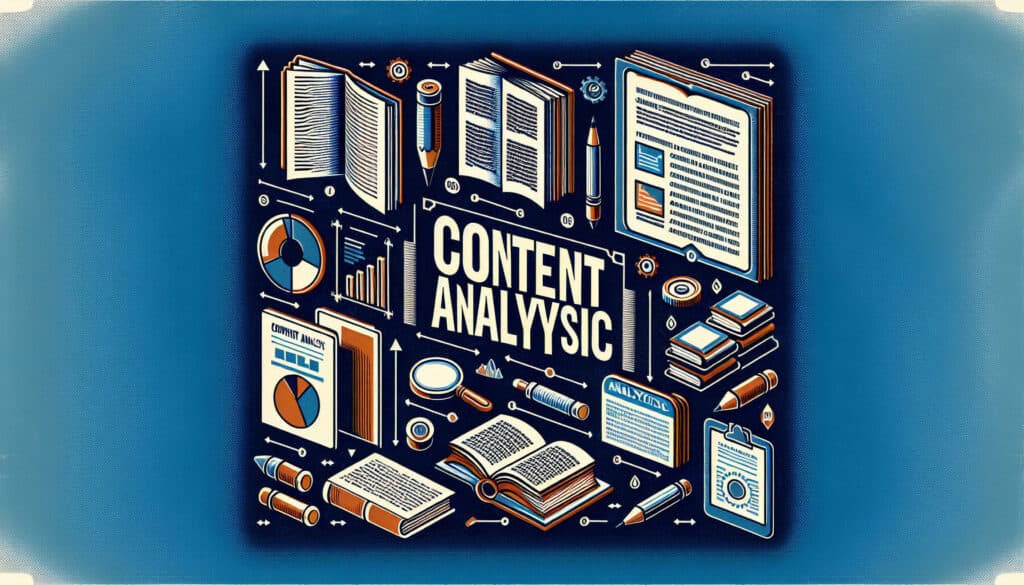Eine Forschungstechnik, die dazu dient, durch Interpretation und Kodierung von Textmaterial replizierbare und gültige Schlussfolgerungen zu ziehen.
- Methodologien: Kunden & Marketing, Ideenfindung, Produktdesign
Inhaltliche Analyse

Inhaltliche Analyse
- Analyse der Varianz (ANOVA), Vergleichende Umweltanalyse, Forschung und Entwicklung, Statistische Analyse, Statistische Prozesskontrolle (SPC)
Zielsetzung:
Wie es verwendet wird:
- Forscher kategorisieren und analysieren systematisch Texte, Bilder oder andere Medien, um Muster, Themen und Bedeutungen zu erkennen. Dies kann quantitativ (Zählen von Wörtern) oder qualitativ (Interpretieren von Themen) geschehen.
Vorteile
- Bietet eine systematische und objektive Methode zur Analyse von qualitativen Daten, kann große Mengen an Textdaten verarbeiten und kann zur Aufdeckung von Trends und Mustern in der Kommunikation verwendet werden.
Nachteile
- Dies kann sehr zeitaufwendig sein, die Entwicklung von Kodierungsschemata kann subjektiv sein, und es kann den Kontext oder die Nuancen der Kommunikation übersehen.
Kategorien:
- Kunden & Marketing, Problemlösung
Am besten geeignet für:
- Systematische Analyse von textlichen oder visuellen Inhalten, um Muster und Themen zu identifizieren und zu quantifizieren.
Die Inhaltsanalyse bietet eine breite Palette von Anwendungen in verschiedenen Bereichen, darunter Marketing, Medienwissenschaft, Sozialwissenschaften und Nutzererfahrungsforschung im Produktdesign. In Branchen wie der Technologieentwicklung oder der Konsumgüterindustrie kann diese Methodik in der Sondierungsphase der Produktentwicklung von entscheidender Bedeutung sein, wenn das Sammeln von Nutzerfeedback aus Umfragen, sozialen Medien, Foren und Kundenrezensionen wertvolle Einblicke in die Bedürfnisse und Vorlieben der Nutzer liefert. Dieser Prozess wird in der Regel von Analysten oder Designforschern eingeleitet, die häufig von funktionsübergreifenden Teams wie Marketingstrategen und Datenwissenschaftlern unterstützt werden, die zur Erfassung und Interpretation der Daten beitragen. So kann beispielsweise ein Unternehmen, das ein neues elektronisches Gerät auf den Markt bringt, Kundenrezensionen und Online-Diskussionen analysieren, um wiederkehrende Themen in Bezug auf Funktionalität, Benutzererfahrung oder allgemeine Probleme der Benutzer zu ermitteln. Dieser Ansatz kann nicht nur die vorherrschenden Meinungen aufzeigen, sondern auch bestimmte Bereiche, die verbessert werden sollten, um Design-Iterationen voranzutreiben. Die Anpassungsfähigkeit der Inhaltsanalyse ermöglicht es, quantitative Elemente - wie z. B. die Häufigkeit bestimmter Schlüsselwörter oder Phrasen - mit qualitativen Interpretationen zu kombinieren, die das Verständnis für die Gefühle der Benutzer vertiefen. Darüber hinaus ist sie aufgrund ihrer Fähigkeit, große Datenmengen zu verarbeiten, besonders nützlich für Unternehmen, die Veränderungen im Verbraucherverhalten oder Trends im Laufe der Zeit verfolgen wollen, um strategische Entscheidungen zu treffen und Innovationen im gesamten Unternehmen voranzutreiben. Produktlebenszyklus.
Die wichtigsten Schritte dieser Methodik
- Definieren Sie die Forschungsfragen oder Ziele, die die Analyse leiten.
- Wählen Sie den Inhaltstyp für die Analyse aus, z. B. Text, Bilder oder audiovisuelle Medien.
- Entwickeln Sie ein Kodierungsschema auf der Grundlage vordefinierter Kategorien oder einer offenen Kodierung.
- Kodieren Sie den Inhalt systematisch und wenden Sie das Kodierschema auf jeden einzelnen Datensatz an.
- Verwenden Sie gegebenenfalls Software-Tools für die Datenverwaltung und die Analyse der kodierten Inhalte.
- Analysieren Sie die kodierten Daten, um Trends, Muster und Themen zu erkennen.
- Interpretieren Sie die Ergebnisse auf der Grundlage der identifizierten Themen und Muster im Kontext der Forschungsziele.
Profi-Tipps
- Einsatz von Softwaretools für die automatische Kodierung und Analyse zur effizienten Bearbeitung großer Datensätze, um menschliche Fehler und Verzerrungen zu minimieren.
- Verwenden Sie gemischte Methoden, indem Sie quantitative Metriken mit qualitativen Interpretationen verbinden, um Ihre Ergebnisse und Validierung zu bereichern.
- Verfeinern Sie Ihr Kodierungsschema kontinuierlich durch iterative Analyse, damit sich neue Themen ergeben, wenn sich Ihr Verständnis der Daten weiterentwickelt.
Verschiedene Methoden lesen und vergleichen, Wir empfehlen die
> Umfassendes Methoden-Repository <
zusammen mit den über 400 anderen Methoden.
Ihre Kommentare zu dieser Methodik oder zusätzliche Informationen sind willkommen auf der Kommentarbereich unten ↓ , sowie alle ingenieursbezogenen Ideen oder Links.
Historischer Kontext
1828
1850
1854
1854
1911
1928
1950
1827
1848
1850
1854
1895
1914
1943
1970
(wenn das Datum nicht bekannt oder nicht relevant ist, z. B. "Strömungsmechanik", wird eine gerundete Schätzung des bemerkenswerten Erscheinens angegeben)















Verwandte Artikel
Master Production Schedule (MPS)
Massenanpassung
Marketing-Trichter
Marketing-Audit
MAPO-Index (Bewegung und Unterstützung von Krankenhauspatienten)
Fertigungsressourcenplanung (MRP II)